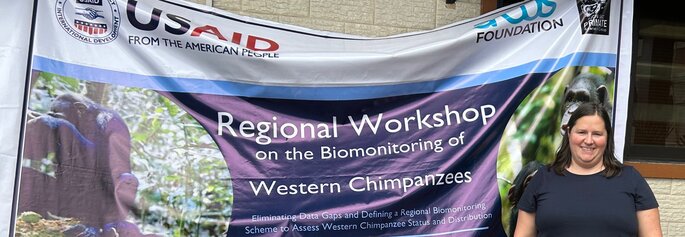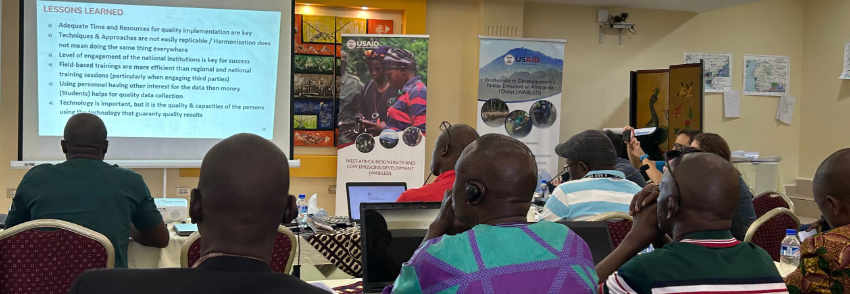Biomonitoring Western Chimpanzees: the why, what, and how

Last week’s regional workshop on biomonitoring of Western Chimpanzees took place in Liberia, and brought together academics, conservationists, government staff from West African ape range states, and private sector developers to define a monitoring approach to assess the status and distribution of this critically endangered species, and work towards eliminating existing gaps in regional survey data.
While a lot of regional biomonitoring currently takes places in nationally protected areas, 83% of Western Chimpanzees reside outside protected areas – where development projects are most likely to be implemented. The global Western Chimpanzee population is estimated to have declined by 80% between 1990 and 2014, and much of their remaining geographic range overlaps with industrial extraction projects, planned large-scale infrastructure development and industrial agriculture.
Defining biomonitoring objectives and methods that are feasible for development projects to implement is key to eliminating gaps in regional survey data on chimpanzee status and distribution, and to support development projects to align with international best-practice for biodiversity management.
Many approaches to monitoring great apes exist, but there is no such thing as a ‘best survey method’. Instead, approaches should consider which method is best suited to a given context and question, and based on the resources available. In other words – why, what and how to monitor great ape populations.

For development projects seeking to align with best practice, the why is typically in order to:
- Ensure appropriate avoidance and minimisation measures are in place to reduce impacts
- Assess impacts to apes
- Monitor progress towards overall net gain to apes, either within concessions or in a designated offset site and enable adaptive management of activities.
What is needed to achieve those three objectives is robust data – on whether the overall population is stable, increasing or decreasing, or in good ecological health. Indicators to measure this include species density and abundance, distribution, group size and composition, reproduction rate and health.
Once the why and what are clearly defined, the how can be determined.
How will depend on the local characteristics of the survey area and the ape population of interest, but also on available capacity and resources, such as field staff, logistics, analytical capacity and long-term sustainability.
There are many methods for monitoring apes, but only DISTANCE sampling with either camera traps or line transects, and spatially explicit capture-recapture (SECR) with either camera traps or genetic sampling have been fully validated for estimating abundance and density.
The table below outlines the different monitoring concerns that development projects typically need to assess to align with best practice. It also shows which monitoring approaches can provide this information. It is better not to rely on a single methodology but use a combination of methods that provide complementary information.
| Monitoring concern | Camera trap | Genetic | Line Transect | Aerial survey | Recce | Interview |
| Presence / Absence | X | X | X | X | X | X |
| Population Abundance | X | X | X | (X) | (X) | |
| Population Density | X | X | X | (X) | ||
| Population Distribution | X | X | X | X | (X) | (X) |
| Health / Disease | X | |||||
| Reproductive Rate | X | |||||
| Demographic structure (community size & composition, age/sex ratio) | X | X | ||||
| Population mobility / genetic diversity / flow | X |
(x) denotes that this approach can sometimes provide such information under certain circumstances or for certain species. For example, aerial surveys may be appropriate for estimating density of solitary orangutans, but not socially living chimpanzees and gorillas; and recce’s can only provide abundance estimates if done extensively and using a semi-systematic approach. Camera trap: Remote triggering cameras are placed in focal habitat to take photos or videos when animals pass. Survey approach can follow a systematic or random design depending on concern to be addressed. Genetic: Faecal samples of focal species are collected and genotyped in a laboratory, to determine individual DNA present. Line transect: Fixed compass bearing following a straight line is walked slowly for a pre-determined distance, and ape nests, faeces and individuals observed along it are counted in order to estimate population size. Aerial survey: Systematic aerial surveys count either ape nests or individuals of species of interest. Recce: A non-systematic walk that follows the path of least resistance along a pre-determined direction or habitat feature (e.g. elephant trail, river). Interview: informal discussion with local population residing in proximity to area of interest, to understand presence / absence and areas of higher density.

Another aim of the regional workshop on biomonitoring of Western Chimpanzees was to support sharing of survey data on the Ape Populations, Environments and Surveys database (A.P.E.S) – an initiative of the IUCN Section on Great Apes to safely archive all global ape population survey data, and provide up to date information on the status of apes.
To date, the majority of survey data uploaded on the A.P.E.S database comes from research and non-governmental organisations working in nationally protected areas. There is a great opportunity for development projects to contribute valuable survey data (typically collected outside of protected areas), not only to support the elimination of survey gaps and contribute to knowledge of great ape status and distribution, but to inform the IUCN International Red List of Threatened Species database.
While development projects may have concerns about submitting such data to a global database, in fact there is a data policy that ensures that:
- Survey data remain the property of the owner / owning institutions
- Survey data is securely stored and can only be accessed via permission from the data owner
- Any party wishing to access original data sets in the A.P.E.S. database must complete a Data Request Form and a formal research proposal.
In terms of next steps post-workshop, priorities are to form working groups to facilitate data collection and processing, enable capacity building and development of key partnerships, and leverage additional funds for this important work. While there is still a lot to be done, there is a great appetite for different sectors to work together on defining monitoring approaches to assess the status and distribution of the Western Chimpanzee, and to eliminate existing gaps in regional survey data to ensure the long-term survival of this Critically Endangered species.
Make Nature Your Business
Find out how you can make nature your business.
